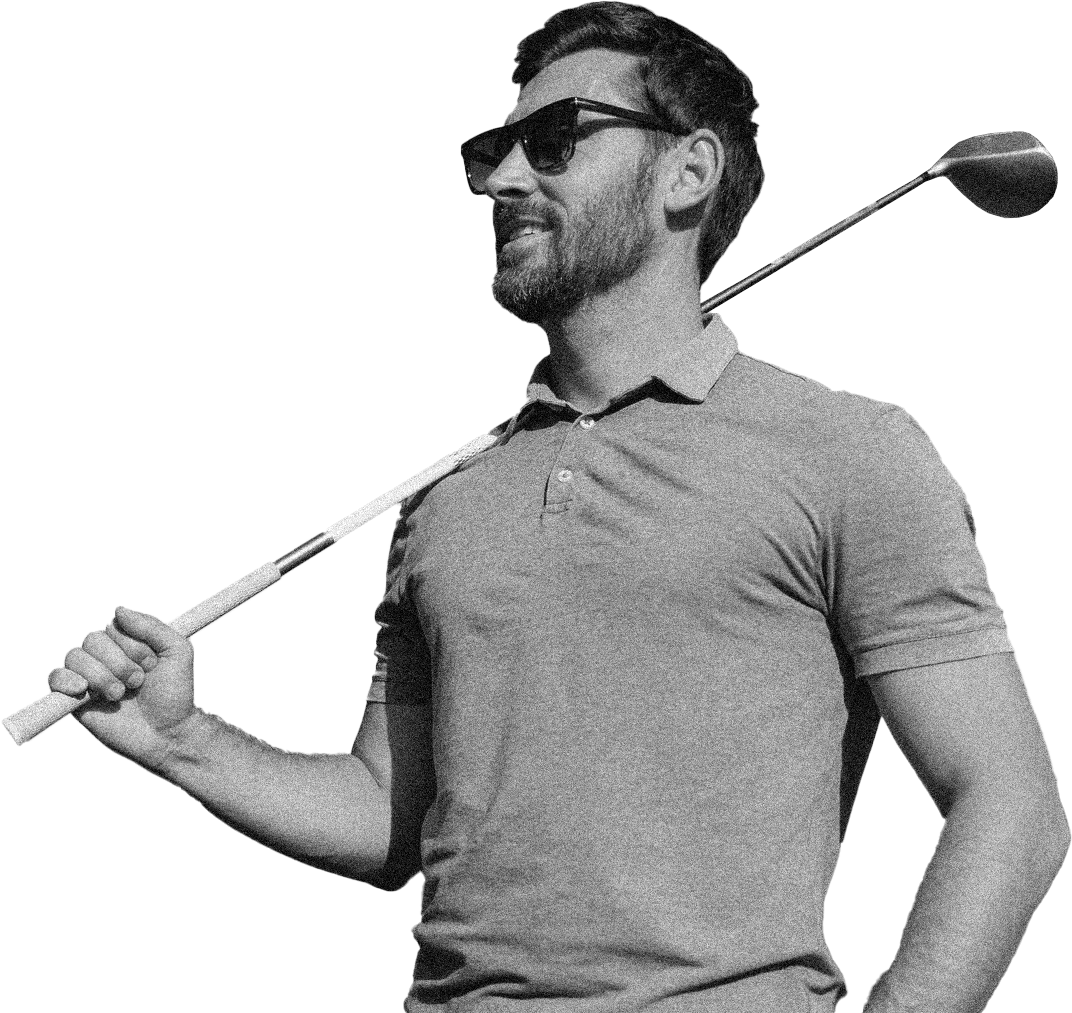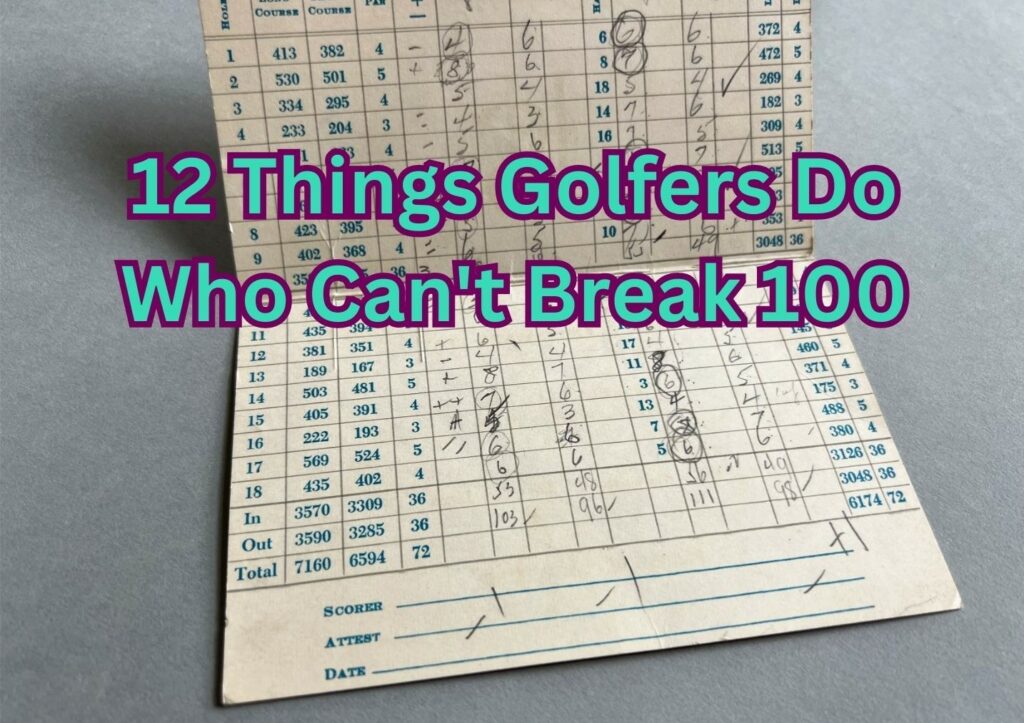During a recent Florida Golf School Vacations program, I had the pleasure of enjoying an 18-hole round of on-course coaching with a regular client. His number one goal is to break 100. And he thought that having me on the golf course could make that happen. After all, I’ve broken 100 a lot over the past 40+ years of playing golf. And I could help him avoid the 12 Things Golfers Do who can’t break 100.
How the 12 Things Golfers Do Who Can’t Break 100 Came About
As he went about playing his round, my client realized that breaking the 100-barrier would take some effort. And he needed basic details to have a chance of breaking 100. He asked a lot of questions that he thought pertained to breaking 100. But those questions were more about fixing things versus doing things within his round that would make the difference. Questions such as whether his swing needed to change mid- round. Or, why he missed a short putt. Each of his questions had something to do with the 12 things golfers do who can’t break 100.
As I rode along, I took copious notes. And after the round, I noticed a lot of common threads between this client and the other current and past clients who could not break 100. Those commonalities are the 12 items listed below.
Are you someone who can’t break 100 and looking to visit me at my Florida Golf Academy? If so, you’re most likely doing any, or all, of the 12 things golfers do who can’t break 100? Let’s find out what those are and how to improve them.
3 Putts, or Worse!
Just on the Front 9, my client 3-putted or worse, on 5 different holes. This added 6 strokes to his total score for the side, 50. Had it not been for the three putts or worse, half of his round showed breaking 100  is when it is grasp.
is when it is grasp.
My client after the round asked me if I thought he could break 100. And when I showed him his putting statistics for the front side, the obvious stared him in the face. He needs to improve his putting.
When you can’t break 100, how do you improve your putting? The answer is 4 different ways.
- Hitting the Sweet Spot of the Putter – If you can’t consistently hit the sweet spot of the putter, you can’t expect to be a good putter. There’s various drills and devices available to work on nothing but hitting the sweet spot of the putter. Whether it’s placing rubber bands around the face of the putter. Or, placing 2 tees in the green to form a gate the putter barely fits through. No matter what the device, striking the middle of the putter is paramount.
- Distance Control– My client’s distance control on the front side of the golf course was sporadic at best. Most of the time, he left his putts short of the hole. As much as 6 feet short. I reminded my client he needed to get the ball to the hole to have any chance of making putt. At that point in the round, his putts ran well past the whole. The #1 cause of all 3-putts or worse is a poorly controlled first distance. To eliminate 3-putts, you need to control your distances. Knowing the average length of your first putt and practicing putts from that distance goes a long way to placing your first putt as close to the hole as possible. Leaving you with…
- Making Short Putts – My client missed 6 putts, inside of 2 feet. I’ll give you the cause in a moment. All putts within 3-feet are best stroked to the back of the hole. With enough pace to gently hit the back of the hole. Within 3-feet, there’s no reason to read any type of break into the putt. Unless the greens are super-fast; 13 or more on the stimp meter this fast. Your ability to strike the ball to the back of the hole, providing you the confidence to strike a putt with acceleration. Increasing your percentage of making putts inside of 3-feet.
- Anxiety – My client’s anxiety level was obvious throughout the round. But most obvious as he got closer to the hole. His lack of experience playing golf with a definite purpose is extremely limited, if not inexistant. Therefore, his ability to keep solid, mentally, physically, and emotionally over a putt from any distance was compromised by his visual need to see if he hit the putt correctly. I see a lot of amateurs do this. Mainly because you’re fixated on the ball going in, forgetting you must make the stroke first before it has any chance of going in. If you can learn to see the blank spot underneath the ball, and count to 2 after the ball has been struck, your chances of starting your putt on its intended line greatly increases. Simply because your shoulders have not moved up and out/open to your stroke when your head is moved forward to see where the ball is rolling.
You’re Attempting to Fix It vs. Play It
I watched my client warm up prior to the round and asked him 5-minutes into the warm-up how he thought his warm-up was going. His immediate reply concern fixing something In his swing. Midway through the front side, I could tell he was consciously attempting to make sure the ball flew in the direction he was intending. Versus setting up and trusting his swing, providing him a good chance at succeeding. I asked him, “Did you try to swing? Or did you ‘steer’ the ball to your target? He immediately answered that he was trying to fix his swing in mid-swing. In turn, steering his shot wildly right of his target.
When you’re playing golf, it’s not about fixing things. It’s about playing the game. It’s about playing with the skills you possess. And making the most of those skills. No matter your skills, good or bad in your mind, you must trust yourself! And just make swings. The more you try to fix your swing the worse your mistakes will be.
Come to my Florida Golf Academy and save the fixing of your swing for our practice facility.
You Aim Poorly
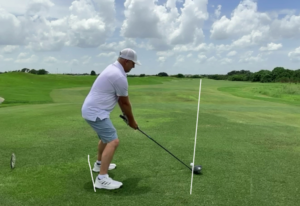 Aiming and aligning properly in my opinion is the #1 set-up position all golfers should achieve and master. Golf is getting a ball from Point A to Point B in the fewest strokes possible. If you’re aiming to Point C instead of Point B, it’s going to take more strokes to get where you want to go.
Aiming and aligning properly in my opinion is the #1 set-up position all golfers should achieve and master. Golf is getting a ball from Point A to Point B in the fewest strokes possible. If you’re aiming to Point C instead of Point B, it’s going to take more strokes to get where you want to go.
In my opinion this is the single biggest mistake all golfers make. At the breaking 100 level, it’s more about understanding what to aim versus what to align. Remember, the golf club strikes the ball, not you. You just hold the golf club. To ensure better aim of the club, it’s best to aim the leading edge of the club, or the bottom of the club, to your intended target. Using an intermediary target that lies on the direct line between the ball, Point A, and your intended target, Point B, is an easier way to optimize your aiming ability. ALWAYS aim the club first! And it’s the only thing you aim!
Once your club is aimed, it’s time to align your body to the club. If done properly, your feet, knees, hips, and shoulders should all be parallel to your target line. For a right-hander, you’re parallel left. If you’re a left-hander, you’re parallel right.
As you look at your target, you may feel like you and your body are miss aimed. But I remind you, the club is the only item you aim. You do not aim your body under any circumstance. Only aim the club.
You’re Choosing the Wrong Club
The second biggest mistake I see most golfers make is making a bad club choice. Specifically, choosing a club that they know can’t carry a specific distance to their intended target.
My client did just that multiple times throughout the 18 holes. At one point, I told him I did not trust his yardages, nor should he. But he kept insisting that certain clubs were going to carry the distances he thought they would. I allowed him to continue, watching 80% of his shots fall short of his targets. Only twice during the round did he choose the correct club for the distance the shot called for. And both times, he mishit the shot thin. Producing a very lucky shot he thought was his average.
If you’re trying to break the 100-barrier, check your ego at the door, and grab the next longest club than the one you think you need, for all your approach shots. Doing so takes 95% of all the trouble on any hole, out of play. Most of that trouble is in front of the green, not behind it. Choosing the longer club will also allow you to swing more freely and easily, without you making vicious whacks at the ball.
You’re Expecting Too Much
 If you’re struggling to break 100, chances are you don’t practice a lot. Nor do you play a lot. If you’re not putting the time in to making improvements to your golf skills, how can you expect your golf skills to produce a score you’re not capable of producing?
If you’re struggling to break 100, chances are you don’t practice a lot. Nor do you play a lot. If you’re not putting the time in to making improvements to your golf skills, how can you expect your golf skills to produce a score you’re not capable of producing?
I have a phrase I provide all clients regardless of their skill level. And I want all my golfers to remember this.
“Expectations lead to eventual failures. Expectations are goals without a plan.”
Whether on the golf course or not, expectations tend to be unrealistic. Or void of goals with a plan to reach each goal. You need a lot of magic dust for expectations to happen. Your magic dust as a golfer is the time you commit to improving your skills.
Going about your business in a very disciplined and detailed way, practicing can be fun and productive. Practice must have a purpose. When you commit to practicing twice as much as you do now, which is next to nothing, focusing on the statistical weaknesses that are obvious in your game, you significantly increase the odds of breaking 100. As well as having no expectation of doing so.
You’re Ignoring the Obvious
Often throughout his round, my client was totally oblivious to the wind and its direction. He was more concerned with the total yardage he had to hit a shot. He was also at times unaware of what hole he was playing. As well as what stroke he was playing. As much as these items seem obvious and common place to most golfers, golfers attempting to break 100 can sometimes be blind to the obvious. Why? Because  they have so many other things on their mind, the obvious is distracted by the information in their mind that is of no value to breaking 100.
they have so many other things on their mind, the obvious is distracted by the information in their mind that is of no value to breaking 100.
Consider the simple yet obvious factors that can influence how the golf ball will fly. Consider where you are within the hole you’re playing. Or within the round. Whether you’re posting scores in the 60s or on the brink of breaking 100, great decisions determine your score. And you must have all the facts to be able to make a great decision.
My suggestion to you if you’re struggling to break 100, is to take your time and let your eyes and ears absorb the obvious with each shot you take. It won’t take long for you to see subtle changes in elevation. The nuances to each green. And the variations and when direction as well as speed. These are just some of the things you should consider when planning for each shot. And it is what we teach you to do at my Florida Golf Academy.
You Play Shots You Do Not Own the Skills For
Twice my client attempted to play a shot that his skills weren’t qualified for. Out of 108 total strokes that’s not a bad ratio. But when those 2 shots accounted for a triple and quadruple bogey, you can argue those 2 decisions cost him a lot more than just those 2 swings.
 Often, you’ll hear a golf coach remind golfers not to hit the “hero shot”. The shot that has the least amount of probability of happening because you’re not skilled enough to pull the shot off. You’ll also hear the phrase, “take your medicine and go on”. Meaning, hit the ball back in play to a spot on the hole where you have a higher probability to hit your next shot well.
Often, you’ll hear a golf coach remind golfers not to hit the “hero shot”. The shot that has the least amount of probability of happening because you’re not skilled enough to pull the shot off. You’ll also hear the phrase, “take your medicine and go on”. Meaning, hit the ball back in play to a spot on the hole where you have a higher probability to hit your next shot well.
It’s not bad advice for someone trying to break 100. Most of the time when you’re trying to play a shot that you don’t possess the skills to perform, you’ll hit an errant shot that results in penalty strokes. Or you’ll end up hitting the same shot again, but from a worse position than the original bad lie. When this happens, isn’t it obvious you don’t have the skills to hit the shot you chose?
As a golfer trying to break 100, you’re willing to try anything to get you there sooner than later. When you choose to play a golf shot you can’t the road to realizing a score in the 90’s gets that much longer. Understand the skills you possess. Or as I call them, “the tools you own.” Check your ego at the door. And be willing to play with the tools you possess. Hitting the shots that you’re capable of performing at a high percentage rate of completion provides you a more probable route to break 100. You’ll be surprised how quickly the penalty strokes go away when you do.
You Do Not Have a Routine
Golfers who routinely shoot in the 100’s, tend not to have a routine.
Meaning, the existence of a consistent pre-shot routine is absent from their game. If the golfer that shoots in the 100’s is extremely inconsistent. If it exists at all. One shot, the golfer may step behind the ball and look for a target. With the next shot, they don’t. One shot, you’ll make some practice swings. The next shot you won’t. When reading a putt, you may stand behind the ball. The next putt, you don’t.
As I tell all clientele regardless of their skill level, consistency starts prior to you making a swing. Routine begins as you approach the golf ball. It consists of determining your lie. Determining the distance of the shot. And how the lie affects our ability to make a good swing with the proper club choice. Choosing the club for the condition comes next. Followed by the same pre-shot routine you use for all shots.
Without a routine, you’ll never be consistent. Which is why golfers who shoot in the 100’s desire more consistency. Begin a pre-shot routine ritual now. And consistency will eventually follow.
Penalties
Penalty strokes can add up over the course of 18-holes. All it takes is a couple of wayward drives. Or an approach shot or 2 that lands short of your target in a hazard. The next thing you know, you’re counting somewhere between four and eight penalty strokes per round. By the way, the average penalties counted during a round of golf totaling 100 or more is 6.
Eliminating penalties off the tee is the first order of business. Are you picking an exact target to hit? Or do you aim for an open field? Your eyes and brain are seeking exact targets. And without an exact target, 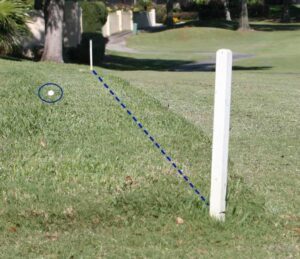 the likelihood of you hitting wayward shots increases. In addition, the choice of using your driver all the time is costing you penalty strokes. Particularly if you can’t control the ball flight. Choose any club but the driver. And I bet you’re in play off the tee a lot more often, eliminating penalty shots.
the likelihood of you hitting wayward shots increases. In addition, the choice of using your driver all the time is costing you penalty strokes. Particularly if you can’t control the ball flight. Choose any club but the driver. And I bet you’re in play off the tee a lot more often, eliminating penalty shots.
Approach shot penalties can be summed up in one phrase. You chose the wrong golf club. You’re most likely choosing a club which has a carry distance that is too short for the shot you’re attempting. Understanding the carry distance of your golf clubs is an essential piece of data that will eliminate penalty strokes quickly. If your target is 150-yards away, and at a 125-yards is a water hazard you must hit over, you must choose the club that carries 150 yards. Not the club that carries 120 and rolls 30. Making this simple adjustment to your club choice decisions can eliminate your hazardous penalty strokes.
You’re Standing Too Far Away from the Ball
Most all golfers stand too far away from the ball when setting up. Particularly golfers who shoot 100 or more. I see this regularly at my Florida Golf Academy. And it ranks as one of the top items in our list of the 12 things Golfers do who can’t break 100.
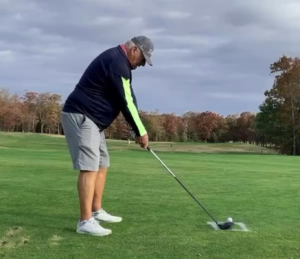 Standing too far away from the golf ball as you set-up creates an imbalance. Placing an undue amount of weight forward into the balls of your feet, if not your toes. As one of my technology partners states, BodiTrak, being on your toes at impact is equivalent to slamming on the brakes of your car. If you’re out of balance on your toes, there’s no way to create efficient club speed with any rotational force. Remember, you’re not the pros you see on TV who know how to leverage the ground to their advantage.
Standing too far away from the golf ball as you set-up creates an imbalance. Placing an undue amount of weight forward into the balls of your feet, if not your toes. As one of my technology partners states, BodiTrak, being on your toes at impact is equivalent to slamming on the brakes of your car. If you’re out of balance on your toes, there’s no way to create efficient club speed with any rotational force. Remember, you’re not the pros you see on TV who know how to leverage the ground to their advantage.
A good way to determine how far you should stand from the ball at set-up is to feel your feet flat on the ground. With an equal amount of weight distributed between toe and heel. Don’t be surprised if this has you standing taller as well as closer to the ball.
Another great way is to make practice swings allowing the club to “bounce” off the ground. As the club is brushing the ground it should also bounce when you make a practice swing. If you’re missing the ground, you’re probably too far away. If you’re digging into the ground as you make a practice swing, you’re probably too close.
You Own No Short Game
Breaking 100 requires you possess a minimal of short game skills. Specifically, knowing how to chip shot.
Most golfers who can’t break 100 never practice their short game. And therefore, have no clue of how to control the distance they hit a chip shot from barely off the green. From 20-yards away from the green,  it becomes a guessing game. It’s a must you have a basic chip shot in your arsenal of shots, to break 100.
it becomes a guessing game. It’s a must you have a basic chip shot in your arsenal of shots, to break 100.
The chip shot not only provides you an opportunity of getting the ball close to the hole. It’s the beginning of your journey to become a better ball striker. The conditions of impact for a chip shot mimic those of a full swing. You’re just making a much smaller swing than normal. Hitting a chip shot, you’re still compressing the golf ball. And if hit straight with a little bit of airtime, you’re returning the club to a square position at impact, while hitting the ball below its equator.
Practicing your chip shot is the beginning of your short game. This one shot can be used in multiple ways throughout a round. It will get you out of trouble situations. It can get you out of a fairway bunker and back on the fairway. It can be used from 10-to-50-yards off the green using a variety of golf clubs.
Conclusion
If your goal is to break the 100-scoring barrier, take heed to the 12 things golfers do who can’t break 100. At a minimum, choose 3 of the points detailed above to work on, for just 1-hour a week. Doing so will provide the experience you need to face 25% of the adversity you face every time you play golf.
Choosing 6 of the points mentioned provides you an even greater opportunity of breaking 100.
Choose the points that you can easily practice. As well as easily implemented on the golf course with little to no effort. Base your choices on facts. Not emotions. The more you can eliminate your emotions from the decision making that influences your score, the easier it will become to break 100.
And when you break 100 for the first time, don’t try to reinvent the wheel. Stick with the game plan that allowed you to reach and exceed that milestone. Be hesitant to change any part of the plan that got you there. Or add anything in addition until you’re comfortable with that strategy every round. That plan will produce a breaking 100 score again. It’s going to take time for that to happen on a regular basis.
Breaking 100 requires focus upon big picture details. Ask any golfer who’s now breaking 90 or even 80, and they’ll tell you the details get smaller and more abundant to reach those scoring milestones. But their scoring milestones are based upon the ones that allow you to break 100. All smaller details to break the other barriers fit into one of these categories. Learn now to accept these categories as your road map to breaking 100. And you’ll soon find out that 90 and 80 are not that far away.




